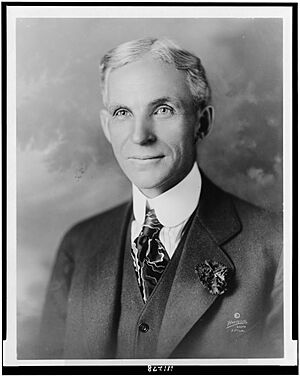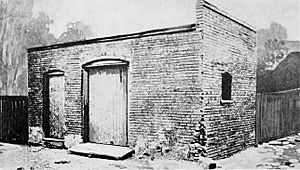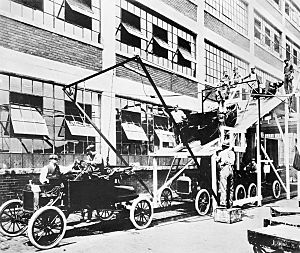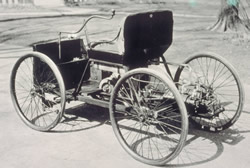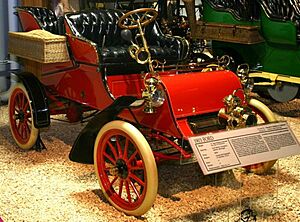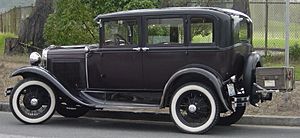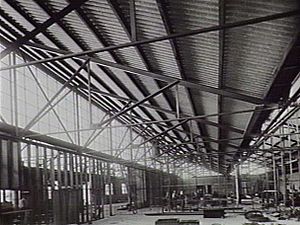History of Ford Motor Company facts for kids
The Ford Motor Company is a famous American car company. It's one of the biggest car makers in the world! Based in Dearborn, Michigan, near Detroit, the company was started by Henry Ford on June 16, 1903. Ford Motor Company grew to be a huge and successful business. It was even one of the few companies that managed to survive during the tough times of the Great Depression. For over 110 years, the Ford family has kept control of the company. Today, Ford makes cars under two main brands: Ford and Lincoln. Ford used to own other fancy car brands like Volvo, Land Rover, Jaguar, Aston Martin, and Mercury, but these were later sold or stopped.
Contents
How Ford Motor Company Started
Henry Ford built his very first car, which he called a quadricycle, at his home in Detroit in 1896. Today, a building called the Michigan Building stands where his home used to be. There's a special plaque there to remember the spot. You can also see a recreated version of his coal shed, where he built the car, at Greenfield Village in nearby Dearborn.
Before Ford Motor Company, Henry Ford tried starting other car companies. He founded the Detroit Automobile Company in 1899, but it didn't do well. In 1901, it was reorganized as the Henry Ford Company. However, Henry Ford left that company in 1902.
He then teamed up with a coal dealer named Alexander Y. Malcomson to get money for a new car company. On June 16, 1903, the Ford Motor Company officially began. It had 12 investors who owned a total of 1000 shares.
Early on, Ford faced legal challenges from a group called the Association of Licensed Automobile Manufacturers. This group claimed they owned the rights to most gasoline-powered cars. After several years of legal battles, the Association finally dropped its case against Ford in 1911.
Early Cars and the Assembly Line
In its first few years, Ford made different car models, from the Ford Model A (1903) to the Model K and Model S. The Model K was Ford's first car with six cylinders and was quite expensive at US$2800. Other cars at the time were much cheaper.
A big change happened in 1908 when Henry Ford introduced the famous Model T. The first Model Ts were built at the Piquette Avenue Plant. In its first full year, 1909, over 10,000 Model Ts were made. As more people wanted the car, Ford moved production to a much bigger place, the Highland Park Ford Plant in 1910. By 1913, the company had developed all the main ideas for the assembly line and making many products at once (mass production).
Ford introduced the world's first moving assembly line that year. This amazing invention cut the time it took to put a car's frame together from 12 and a half hours to just 2 hours and 40 minutes! This made it possible to build many more cars each year.
Working on the assembly line was tough for employees, and many workers left. This caused delays and extra training costs. In January 1914, Ford solved this problem by doubling workers' pay to $5 a day. They also cut shifts from nine hours to eight hours for a five-day work week. This made workers happier, and fewer people quit. Productivity went way up, and the cost of each car went down. Ford kept lowering prices and created a system of car dealers who were loyal to his brand.
Ford became an international company in 1904 by starting Ford of Canada. Then, in 1911, the company quickly expanded overseas. They opened assembly plants in Ireland (1917), England, France, Denmark (1923), Germany (1925), Austria (1925), and Argentina (1925). Factories also opened in Japan (1925), South Africa (1924), and Australia (1925). By the end of 1919, Ford was making half of all cars in the United States and 40% of all British cars. By 1920, half of all cars in the U.S. were Model Ts. The assembly line changed the car industry forever. Soon, companies without it struggled to survive.
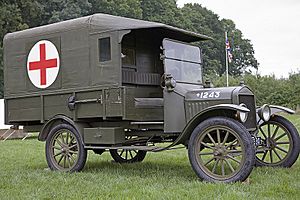
The assembly line also changed technology. Henry Ford famously said, "Any customer can have a car painted any color that he wants so long as it is black." Before the assembly line, Model Ts came in many colors. But with the assembly line, paint had to dry very quickly. Only Japan Black paint dried fast enough. Other colors didn't come back on the Model T until 1926.
In 1915, Henry Ford went on a peace trip to Europe to try and stop World War I. This made him very popular. Later, Ford supported the war effort, and the Model T was used for Allied military vehicles, like the 1916 ambulance.
After World War I
Lincoln Motor Company
On February 4, 1922, Ford bought the Lincoln Motor Company. This helped Ford get into the fancy car market. Henry M. Leland had started Lincoln in 1917 and named it after Abraham Lincoln, whom he admired. Later, in 1938, the Mercury division was created to make cars that were a step up from regular Fords but not as luxurious as Lincolns.
In 1929, Ford Motor Company opened The Henry Ford, a huge museum about American history. Henry Ford even bought Abraham Lincoln's chair, which he was sitting in when he was assassinated. This chair is now displayed at The Henry Ford museum, along with John F. Kennedy's Lincoln presidential limousine.
The Great Depression
During the Great Depression, many people lost their jobs, and car sales dropped a lot. Ford, like other companies, had to make fewer cars and let go of workers. By 1932, 30% of people in Detroit were unemployed.
Henry Ford believed that unemployed people should try harder to find work. This made many people angry. On March 7, 1932, thousands of unemployed workers marched to Ford's River Rouge plant to ask for more help. The protest turned violent when police used tear gas and icy water. When protesters threw rocks, the police and security guards fired guns at the unarmed crowd. Four men were killed, and many more were hurt.
Ford's Role in World War II
Before the U.S. joined World War II, Ford was careful about helping the Allied military. Henry Ford believed that peaceful trade was the best way to avoid war. Ford had a factory in Germany. In 1938, Henry Ford received a special medal from the Nazi government.
Henry Ford had said that war was a waste of time. He was also worried that the Nazis might take over Ford factories in Germany. In 1940, Henry Ford even stopped a plan to build airplane engines for the Allies.
After the attack on Pearl Harbor in December 1941, the U.S. entered the war. Ford then fully supported the war effort. The company became a major part of what President Roosevelt called the "Arsenal of Democracy." This meant using factories to make things for the war. Henry Ford, who was 76 and getting older, played a smaller role. His son, Edsel Ford, made most of the decisions.
Ford produced a huge amount of war materials: 390,000 tanks and trucks, 27,000 engines, 270,000 Jeeps, and over 8,000 B-24 Liberator bombers. They also made hundreds of thousands of parts and tools for the war. Ford's new Willow Run factory was built to make B-24 bombers. Ford's efforts helped the Allies win the war.
After World War II
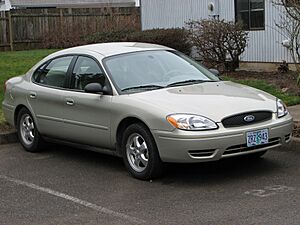
In 1943, Edsel Ford, Henry's son, sadly died. Henry Ford decided to take control of the company again, but he was 78 years old and not well. There was a real chance the company could fail. The U.S. government even had a plan to take over Ford if needed, to make sure vital military production continued.
At this point, Henry Ford's wife and daughter-in-law stepped in. They demanded that he give control to his grandson, Henry Ford II. They threatened to sell their shares if he refused. Henry was angry but had no choice. When Henry Ford II, known as "Hank the Deuce," took over, the company was losing a lot of money.
Henry Ford died on April 7, 1947, at age 83. Thousands of people came to pay their respects. His funeral was a big event, with an estimated seven million people mourning his death across the country.
In 1956, Ford became a company whose shares could be bought and sold by the public. The Ford family still owns about 40% of the company, which gives them a lot of control. Also in 1956, Ford won the "Car of the Year" award for focusing on safety improvements in its new cars.
Ford introduced the famous Thunderbird in 1955. In 1958, they launched the Edsel brand, but it didn't sell well and was stopped in 1960. Ford bounced back quickly by introducing the smaller Falcon in 1960 and the very popular Mustang in 1964. By 1967, Ford of Europe was created.
Lee Iacocca helped design many successful Ford cars, especially the Mustang.
In 1998, a woman named Elsa Iwanowa sued Ford Motor Company. She had been forced to work as a slave laborer for Ford's German branch during World War II. Ford admitted that she and others had a "sad and terrible experience." The court dismissed her case, but later, other German companies agreed to pay money to surviving slave laborers. In 2000, Ford also agreed to contribute $13 million to this fund.
Ford's History in Brief
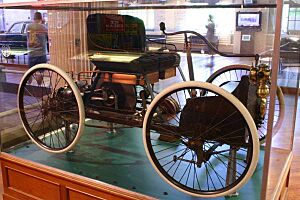

- 1896: Henry Ford builds his first vehicle, the Quadricycle, using a buggy frame and bicycle wheels.
- 1901: Henry Ford wins a big car race in Grosse Pointe, Michigan.
- 1903: Ford Motor Company is officially started with 11 investors. The Model A "Fordmobile" is introduced.
- 1904: Ford Motor Company of Canada is started in Walkerville, Ontario.
- 1906: Ford becomes the best-selling car brand in the U.S.
- 1908: The famous Model T is introduced. Over 15 million are made by 1927.
- 1909: Ford Motor Company (England), also known as Ford of Britain, is established.
- 1911: Ford opens its first factory outside North America in Manchester, England.
- 1913: The moving assembly line is introduced at the Highland Park Ford Plant. This makes Model T production 8 times faster.
- 1914: Ford introduces a $5 daily wage for workers, which was double the usual pay.
- 1918: Construction begins on the huge Rouge assembly plant.
- 1919: Edsel Ford takes over as Company President from his father, Henry.
- 1921: Ford makes over 1 million cars per year, much more than its closest competitor, Chevrolet.
- 1922: Ford buys Lincoln Motor Company for US $8 million.
- 1925: Ford introduces the Ford Tri-Motor airplane for airline services. A factory is built in Yokohama, Japan.
- 1926: Ford Australia is founded in Geelong, Victoria, Australia.
- 1927: Model T production ends. Ford introduces the next generation Model A.
- 1929: Ford makes 1.5 million cars in a year, regaining its top production spot.
- 1932: Ford introduces the first low-priced car with a V8 block, the Model 18.
- 1938: Henry Ford receives a high medal from Nazi Germany.
- 1939: The Mercury division is created for mid-priced cars.
- 1941: The Lincoln Continental is introduced. Ford starts building "jeeps" for the military.
- 1942: Ford stops making civilian cars to focus on producing bombers, tanks, and other war supplies.
- 1943: Edsel Ford dies. Henry Ford becomes president again.
- 1945: Henry Ford II becomes president.
- 1947: Henry Ford dies at age 83. Henry Ford II becomes the new chairman.
- 1948: The F-1 Truck is introduced.
- 1949: New post-war era Ford cars are introduced.
- 1954: The Thunderbird is introduced. Ford starts crash testing cars.
- 1956: Ford's World Headquarters is opened. Ford's shares become available to the public.
- 1957: Ford is the top-selling brand, making 1.68 million cars.
- 1958: Ford launches the Edsel brand.
- 1959: Ford stops making the Edsel.
- 1960: The Ford Galaxie and compact Ford Falcon are introduced.
- 1964: The Ford Mustang is launched, starting the "pony car" class. The Ford GT40 challenges Ferrari at LeMans.
- 1965: Ford's U.S. sales go over 2 million cars.
- 1966: The Ford Bronco sport utility vehicle is introduced.
- 1967: Ford of Europe is created by combining Ford's British and German operations.
- 1968: The Lincoln Mark Series is introduced.
- 1973: Ford's U.S. sales reach an all-time high of 2.35 million vehicles.
- 1974: The Ford Mustang II debuts as a smaller, more fuel-efficient pony car.
- 1976: Ford of Europe launches the first Ford Fiesta.
- 1978: Ford Motor Company celebrates its 75th anniversary.
- 1979: Ford buys a 25% share in Mazda.
- 1981: The Lincoln Town Car and Ford Escort are introduced.
- 1985: The Ford Taurus is introduced with a new "aero design" style. The Ford Aerostar minivan is also launched.
- 1987: Ford buys Aston Martin and Hertz Rent-a-Car.
- 1987: Henry Ford II dies at age 70.
- 1989: Ford buys Jaguar. The Mazda MX-5 Miata is shown.
- 1991: The Ford Explorer is introduced, making SUVs popular family vehicles.
- 1992: The Ford Taurus becomes America's best-selling car.
- 1995: The new front-wheel-drive Ford Windstar minivan is introduced.
- 1996: Ford increases its ownership in Mazda to 33.4%.
- 1997: The large 4-door SUV Ford Expedition is introduced.
- 1998: The Lincoln Navigator creates the luxury SUV class. The Focus replaces the Escort in Europe.
- 1999: Ford buys the Volvo car division. Bill Ford becomes Chairman of the Board.
- 2000: Ford buys the Land Rover brand from BMW. The Lincoln LS and Jaguar S-Type are introduced.
- 2001: The retro-styled Ford Thunderbird is introduced.
- 2003: Ford Motor Company celebrates its 100th Anniversary. The Ford GT is released.
- 2004: The Ford Escape Hybrid, the first gasoline-electric hybrid SUV, is introduced.
- 2005: The Ford Mustang is redesigned with a classic 1960s look.
- 2006: The Ford Taurus ends production after 20 years. The Ford Fusion, Mercury Milan, and Lincoln Zephyr are introduced. Bill Ford steps down as CEO, and Alan Mulally becomes President and CEO.
- 2007: Ford sells Aston Martin.
- 2008: Ford sells Jaguar and Land Rover to Tata Motors.
- 2009: Ford announces it will bring more of its European cars to North America.
- 2010: Ford sells Volvo Cars to Geely Automobile. The third generation Ford Focus is shown.
- 2011: Mercury production ends. The Lincoln Town Car is discontinued.
- 2012: The fourth generation Mondeo/Fusion is previewed, bringing Ford's mid-size cars back to a single platform for Europe and North America.
- 2014: The Ford Mustang celebrates 50 years with its sixth generation launch. The 2015 F-150 is launched, using a lot of aluminum in its body.
Images for kids
-
Former Ford CEO Alan Mulally, who helped restructure the company


